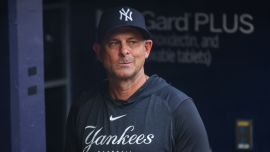
NEW YORK — Add another year to the second-longest World Series drought in New York Yankees history. The Yankees dropped Game 4 of the ALDS (TOR 5, NYY 2) Wednesday night at Yankee Stadium, sending them packing for the winter by the AL East rival Toronto Blue Jays. The Yankees remain titleless since 2009.
Excluding their time as the New York Highlanders prior to 1913, the longest World Series drought in Yankees history is 17 years from 1979-95. Their current drought is up to 16 years, the sort of gap that makes fans of other teams roll their eyes while simultaneously driving Yankees fans crazy. Last year’s World Series loss to the Los Angeles Dodgers didn’t help matters.
Objectively, the Yankees had a great season. They won 94 games, tied for the most in the American League, and had the circuit’s best run differential by 54 runs. The Yankees did that despite losing Gerrit Cole to Tommy John surgery and reigning AL Rookie of the Year Luis Gil to a lat strain, both in spring training. Cole missed the season. Gil returned in August and was diminished.
The Yankees also lost the season series and thus the tiebreaker to the Blue Jays, which cost them the AL East title and sent them to the Wild Card Series. They got through the Boston Red Sox, then wasted Aaron Judge‘s heroic Game 3 effort in the ALDS loss to the Blue Jays. The Yankees got outscored 34-19 and outhomered 9-4 in the four games.
Judge will turn 34 in April and another season of his historically great peak has come off the calendar. The clock is ticking on the Yankees’ window to win a World Series while their franchise player is the best hitter since Barry Bonds. Like every other team, the Yankees have questions to answer this offseason, include a few big ones. Here’s a look at what the Yankees face this winter.
Yankees eliminated from MLB playoffs: Could Brian Cashman, Aaron Boone’s stability be part of the problem?
Mike Axisa

Where did the bullpen magic go?
And, more importantly, how do they get it back? That might be the single biggest question facing the Yankees this offseason. The team’s shaky bullpen cost them an AL East title and Wild Card Series bye during the regular season, and it cost them Game 1 in the first round. It is really, really hard to win the World Series with anything less than a good bullpen these days.
For much of what we’ll call the Aaron Judge era, the Yankees have had one of baseball’s best and deepest bullpens, but that has not been the case the last few years. Here are the bullpen’s ranks since Judge’s rookie season in 2017:
|
2017 |
3rd in MLB |
1st in MLB |
11th in MLB |
|
2018 |
4th |
1st |
3rd |
|
2019 |
9th |
1st |
5th |
|
2020 |
16th |
20th |
20th |
|
2021 |
4th |
3rd |
8th |
|
2022 |
3rd |
4th |
5th |
|
2023 |
1st |
14th |
6th |
|
2024 |
6th |
20th |
6th |
|
2025 |
23rd |
21st |
20th |
Other than the 60-game 2020 season, the Yankees perennially had one of baseball’s best bullpens from 2017-23, if not the best. The cracks began to form in the second half of 2023 and in 2024 though, as the bullpen’s WAR didn’t align with its ERA and win probability added. The results (ERA and WPA) were strong. The underlying performance (WAR) carried red flags.
Things collapsed this year. Devin Williams did not meet expectations in what is likely to be his only season in New York, though he was hardly the only culprit. Luke Weaver, who was so good in 2024, regressed in 2025. Tim Hill gave up almost as many home runs in 2025 (eight) as he did from 2022-24 combined (10). Mark Leiter Jr. was ineffective. Fernando Cruz was inconsistent.
The Yankees tried to address their bullpen at the trade deadline, and pretty aggressively at that. David Bednar took control of the closer’s job and was very good overall. Camilo Doval struggled and was demoted out of high-leverage work though, and Jake Bird was so bad he wound up in Triple-A almost immediately. Others like Paul Blackburn, Yerry De Los Santos, and Brent Headrick barely moved the needle.
Major injuries (Jake Cousins, Jonathan Loáisiga, etc.) took bullpen depth and impact away from the Yankees, but that’s baseball. No team gets through the season with a fully healthy bullpen and the Yankees know that. Their moves to address those absences were not enough to compensate, be it internal promotions (De Los Santos, Headrick) or outside additions (Bird, Doval).
To fix the problem — an unreliable bullpen, in this case — you have to first understand the problem. Are the Yankees no longer good at identifying bullpen talent? Are they no longer able to coach up relievers and make them better, a strength of theirs from 2017-23? It is likely a combination of both: not bringing in the right guys and not improving the guys they have.
Bullpens are inherently volatile. It is a bunch of imperfect pitchers (that’s why they’re relievers in the first place) performing in small sample sizes. After the impressive run of bullpen-building from 2017-23, the Yankees were bound to run into a down period at some point. That point has arrived. Bullpens are just so important though. They have to get this unit back on the rails. It is a must.
What does the outfield look like in 2026?
By any measure, the Yankees had the best outfield in baseball in 2025. It wasn’t close, really. Of course, Judge played a major role in that, but a flexor strain limited him to only 822 ⅓ innings in the field and 425 plate appearances as an outfielder. He made up just 19% of the outfield’s defensive innings and 20% of their plate appearances. Judge spent the rest of his time at DH.
Here are the numbers on New York’s outfield this season:
|
AVG |
.276 (1st in MLB) |
Red Sox (.265) |
|
OBP |
.363 (1st) |
Mets (.341) |
|
SLG |
.507 (1st) |
Cubs (.464) |
|
OPS+ |
140 (1st) |
Cubs (120) |
|
HR |
112 (1st) |
Angels (96) |
|
WAR |
16.6 (1st) |
Red Sox (14.4) |
Judge was Judge. Trent Grisham slugged 34 homers, double his previous career high (17 in 2022), and went from fourth outfielder to starting center fielder. Cody Bellinger had a 5-WAR season, his best since his 2019 NL MVP year. Jasson Domínguez performed well against righties (113 OPS+) before Bellinger stopped moving around and took over as the everyday left fielder in September.
The outfield was the strength and most productive part of the Yankees this season. The good news is Judge will be back next year, and the next five years after that too. Domínguez still has five years of team control remaining. Grisham will be a free agent though, and Bellinger seems likely to join him by declining his $25 million player option for 2026 to seek a long-term contract.
Depending who you ask, top prospect Spencer Jones is knocking on the door of the big leagues after finishing second in the minors with 35 homers. The 25th overall pick in the 2022 Draft also stole 29 bases and nearly became the first non-veteran journeyman minor-leaguer to have a 30-30 season since Kyle Tucker (34 HR and 30 SB) and Luis Robert Jr. (32 HR and 36 SB) in 2019.
At the same time, Jones struck out in 35.4% of his plate appearances this season, the highest rate among the 209 players with at least 500 plate appearances in the minors. At minimum, Jones’ career-long strikeout issues create questions about his ability to help the 2026 Yankees in a meaningful way. Longer term, prospects who strike out this much have higher-than-average bust rates.
The Yankees know they can start their 2026 outfield with Judge in right and Dominguez in left. That’s a pretty good foundation. The question is who plays center? Is it Jones, who is a gifted defender despite his size (6-foot-7 and 240 lbs.)? Do they attempt to bring back Bellinger and/or Grisham? If not, that’s an awful lot production walking out the door that won’t be easy to replace.
Tucker will be the top free agent on the market this winter, though he would be an imperfect roster fit for the Yankees as another natural right fielder. It’s one thing to play Judge in center for one season to accommodate Juan Soto. It’s another to do it long-term as he gets deeper into his 30s. Is Tucker in left, Dominguez in center, and Judge in right doable? A wonky alignment, it would be.
Other potential center field free agent (Harrison Bader, Cedric Mullins, etc.) and trade (Robert, Alek Thomas, etc.) candidates aren’t especially appealing. From where I sit, the Yankees should just re-sign Bellinger. It’ll be too many years and too many dollars, but he brings so much to the table (contact, power, defense, baserunning) and fits their roster and ballpark so well. It just works, you know?
One way or another, the Yankees will have to rebuild baseball’s most productive outfield this offseason. It will be difficult, but not impossible. Replacing Soto seemed impossible, but the Yankees finished with the same record, a better run differential, and with more runs scored without Soto in 2025 than they did with Soto in 2024. Rebuilding the outfield will again be a winter priority.
Are any changes coming higher up in the organization?
The Yankees have had impressive organizational stability and continuity. General manager Brian Cashman has been at the helm since 1998 (and was a longtime front office member before that) and the Yankees have had only three managers in the last 30 years (Joe Torre, Joe Girardi, Aaron Boone). This is the same team that changed managers 11 times from 1978-82 under George Steinbrenner.
It has been 33 years since the Yankees last had a losing season, and they’re in the playoffs almost every year. Based on that, the organizational stability is justified. At the same time, the Wild Card Series was the first time the Yankees beat a non-AL Central team in a postseason series since 2012. No disrespect to the AL Central, but against teams more on their level, the Yankees bow out consistently in October.
Roster changes are coming this offseason because they always do, and chances are the Yankees will swap out a member of their coaching staff or two as well. Almost every team has some level of coaching staff shuffling each winter. But are any bigger changes coming? Is there any heat whatsoever on Boone and/or Cashman after a relatively quick postseason exit?
My hunch, and I emphasize this is only a hunch, is no. Cashman is about as secure as any head baseball operations executive in the game. Frankly, given the Yankees’ successful Plan B pivot after losing Soto, I would not be surprised to see him get some Executive of the Year support. I’m not saying he’ll win it, but successful offseason pivots like this typically get some votes.
Boone signed a two-year contract extension in February that won’t even begin until 2026. He is held in high regard by Cashman and owner Hal Steinbrenner, and those are two people you want in your corner. And, frankly, you can only blame so much on Boone this year. No one pitched well in the ALDS and, for long stretches of time this year, he had no one reliable in the bullpen. Boone could only play who was available to him.
You can never rule out a managerial change, even after a 94-win season, though Boone does seem secure. I would say a Boone firing would qualify as a surprise. Cashman is more likely to be elevated to, say, a team president position than he is to be pushed out the door. And if he is elevated, he would have a say in picking his replacement, if not make the pick outright (vice president of baseball operations Tim Naehring has been viewed as Cashman’s eventual successor).
The Yankees would be justified sticking with the status quo. It is also fair to question whether this leadership group can win a World Series given the outcome of their last 15 seasons. There’s a lot of great regular seasons and bullying overmatched opponents in October, then quick exits when facing other the league’s other top teams. At some point, it’s not a coincidence. It’s the result of a flaw in the process.
This news was originally published on this post .






Be the first to leave a comment